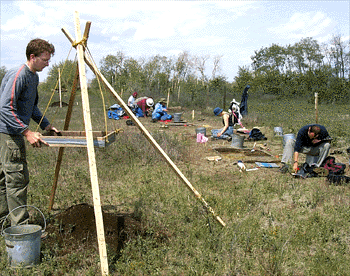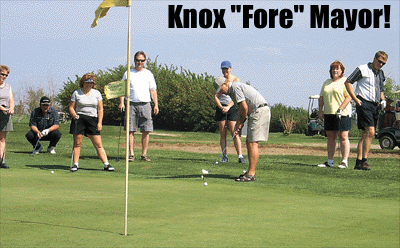|
|
|
 |
An archeological field training school is underway a couple of miles south west of Bodo where 20 University of Alberta students and one volunteer are unearthing a rich find of pottery, arrowheads and bison remnants. The work is part of a project that was underway in the summer of 2000 (see PN July 2000) under the direction of Terrance Gibson, Ph.D., of Alberta Western Heritage Inc., St. Albert along with assistant Elizabeth May who is an archaeological analyst. The area is a large pre-historic bison kill, processing and habitation site. Early results indicate the presence of rich occupational areas with hearths and pits, artifacts and excellent preservation of organic material. The students began unearthing objects estimated to be 1,000 years old on June 10 and will finish this portion of their studies July 5. The vast site is now being used as an introductory course for U of A students in basic archeological techniques. It’s split into three main components: field excavations and mapping of a prehistoric site; site location strategies; lab work on excavated materials. |
|
Myles Chykerda operates a screen in a search for material that may be up to 1,000 years old at a dig south west of Bodo. ©Provost News Photo.
Want to Subscribe to The Provost News? Click here. |
|
|
Graduate students in the archeological field, Darryel VanDerHoek/Sowan and Tim Panas of Edmonton told The News at the site, on crown land and just west of the summer of 2000’s site that the area could be used for the next few years for study and excavation by students. VanDerHoek/Sowan says the site is “really huge” and Panas points out that the site is on a par with the World Heritage site called Head-Smashed-In Buffalo Jump in southern Alberta. Head-Smashed-in Buffalo Jump was developed as an interpretive site and the pair say that at this stage nothing should be ruled out for the Bodo site. If a permanent site was developed in the area it could be sped along with interest from local people, First Nations and government. They added that the site is being excavated in an attempt, among other things, to try to find out why the human site was there. Near or even on top of the surface those trained can pick out pottery, pieces of bone and tools. The animal remains are mainly bison. No human remains have been discovered. No one yet knows how big the site extends and that is also part of what is trying to be determined. So far the group is looking at an area of one square kilometer. Artifacts are being taken to the Bodo Community Centre (old school) where they are cleaned and catalogued and will then be taken to the Provincial Museum. Some students will study the remnants during the winter. The materials being discovered come from the late Prehistoric and iron trade ages that comprised bow and arrow technology (500 to 1500 A.D.). The iron artifacts suggest trade between the arriving Europeans who mainly used fur trading routes and people from the Blackfoot or Plains Cree nations or some other group. This area was the traditional boundary between the Blackfoot and the Cree. VanDerHoek/Sowan and Panas state that this is a “very” significant site, adding that it’s unique because of the amount of material that is showing up. In an interview two years ago, Gibson said that this area was used to trap bison in a pound where they were killed by shooting numerous small arrows into them. He said at the time that the pottery find is “quite rare” in Alberta. By law, artifacts are property of the Crown which go to the Provincial Museum, but if a local museum can demonstrate that they can properly look after the relics, they can all be returned to the community. Meanwhile some other university students who didn’t attend the Bodo dig had a chance to go to a six week field school at Lake Baikal in Russia that got underway June 15. The Siberia project, which involves excavation of a Neolithic gravesite, is a joint venture between the U of A and the Department of Archaeology in Irkutsk State University, Russia. Students there will receive training in a variety of fieldwork methods, such as grave and burial excavation and documentations, data collection, topographic survey and identification, and removal and curation of skeletal material. VanDerHoek/Sowan says that on this Saturday (June 29) they are hosting a public open house in Bodo beginning at 2 p.m. for anyone to attend. People will also be invited to see the dig sites. Print Version in June 26 Edition of The Provost News Check out a other Bodo Dig story from a previous Provost News edition by clicking here. Want to Subscribe to The Provost News? Click here.. |
|
|
|
|
 |
Mayor Ken Knox demonstrates just how it’s done as he putts the ball during an annual town golf tournament on Friday afternoon.
The event was held for town staff, councillors and volunteers associated with the town. There were 32 people golfing at 3 p.m.with supper following. Prizes were donated for golfers. ©Provost News Photo. |
|
|
|
|
Woman Bowls Twice A Week Despite Losing Vision Story and Pictures in June 26 edition of The Provost News Want to Subscribe to The Provost News? Click here. |
|
|
| School Students Meet Pen Pals, Tour Army Base Story and Picture in June 26 edition of The Provost News Want to Subscribe to The Provost News? Click here. |
|
|
| Street Spokesman "What Do You Think Most People Are Searching For?" is the question this week. Check out the June 26 edition of The Provost News for the answers. Want to Subscribe to The Provost News? Click here. |
|
This, along with many other stories and pictures can be found in this week's edition of The Provost News. Subscribe to the award winning paper by clicking on this link and following the instructions on our secure on-line ordering centre. Take me to the Secure On-Line Ordering Centre |